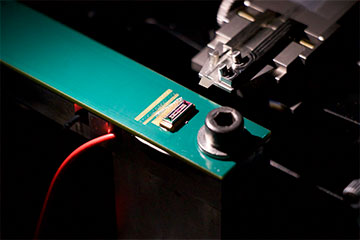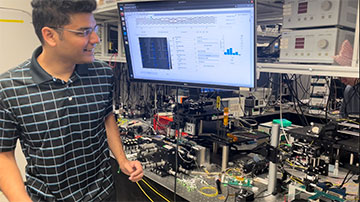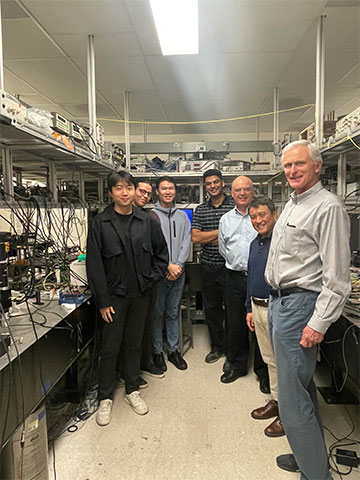
The new study demonstrates a photonic blockchain using a photonic integrated circuit, the small metallic rectangle shown in the image. [Image: Stanford University]
As Bitcoin and other cryptocurrencies grow in size and popularity, their processing eats up an ever-greater fraction of the world’s electricity supply. But a collaboration between researchers in the United States and Italy has now shown it might be possible to slash that consumption while still maintaining network security by using integrated photonic circuits to implement a modified type of proof-of-work blockchain (Optica, doi: 10.1364/OPTICA.476173).
Bitcoin and blockchain
Bitcoin enables decentralized, censorship-resistant transactions thanks to the way that those transactions are parceled up into blocks and verified by individuals or organizations known as miners. Miners from around the world compete with one another to process each block and add it to the blockchain. They do so about once every ten minutes, with the winner in each case being awarded a certain amount of bitcoin.
Adding a block involves using a so-called hash function to convert the block’s transaction data into a fixed-length string of bits. The resulting “hash” uniquely identifies the block in question and is referenced by all successive blocks. Since it is essentially impossible to reverse the process to derive the original data from their associated hash, the blockchain serves as an immutable record of irreversible transactions—making it attractive for a range of other applications, such as safekeeping contracts, preserving medical data and counting votes.
Hashing is designed to be complex—and to become more complex with time—to guarantee the network’s security. But that, in turn, means that competing miners have to invest in increasingly powerful processors and consume an ever-growing amount of electricity. As of 2021, cryptocurrency mining consumed more energy than all of Sweden.

Sunil Pai (pictured) and researchers in the US and Italy have used interferometers in an integrated photonic circuit to demonstrate the feasibility of LightHash, a new cryptographic scheme designed to reduce the energy needed for mining Bitcoin. [Image: Stanford University]
More on hardware, less on electricity
In the latest work, Sunil Pai, David Miller and colleagues at Stanford University, working with researchers at New York University and the non-profit organization PoWx—all in the United States—and others at the Polytechnic University of Milan, Italy, propose using integrated photonics to limit energy consumption. Their scheme still involves a proof-of-work blockchain—one that relies on computational effort (verified by other miners) to certify blocks. But rather than using Bitcoin’s SHA-256 hash function, the scheme instead employs a function optimized for energy-efficient analog photonic chips.
The chips are built up from Mach-Zehnder interferometers, which consist of beam splitters and phase shifters incorporated into waveguides. The interferometers are arranged and manipulated in such a way that laser light passing through the circuit and then measured at the device’s output provides the answers to specific matrix multiplications—a key part of processing hash functions. Although energy is needed to convert electric currents into light and back again, as well as to tune the interferometers, the researchers say the passive nature of the calculations should save a lot of energy overall.
As the researchers explain, their overall goal is to change the way that miners allocate resources—incentivizing them to spend more on their hardware and less on electricity. In this way, they argue, cryptocurrency mining should become less concentrated in those areas of the globe that receive the cheapest electricity while also becoming more resilient to fluctuating energy prices.

From left to right: Taewon Park, Carson Valdez, Zhanghao Sun, Sunil Pai, David Miller, Shanhui Fan and Olav Solgaard. [Image: Stanford University]
LightHash, a new function
Authors Bogdan Penkovsky and Michael Dubrovsky of PoWx have previously outlined an optics-friendly hash function known as HeavyHash. This function is currently being tested on two smaller cryptocurrency networks, but it is very susceptible to errors in the analog optical hardware, such as loss or coupling mismatches. The new function, known as LightHash, is designed to overcome these problems by optimizing the trade-off between circuit size and accuracy and by averaging the outputs from multiple copies of the same circuit.
To demonstrate the potential of this scheme, the researchers ran computer simulations and experimentally tested an interferometer network capable of processing matrices with as many as four rows and columns. They found that the likelihood of errors shot up dramatically as the number of inputs and outputs increased, but they also showed that using four copies of the circuit can reduce the rate of errors in hashing by up to four orders of magnitude.
Future outlook
Despite their scheme’s susceptibility to errors, Pai and colleagues conclude that it could make photonic blockchains a reality—reducing energy consumption by up to a factor of seven. They add that the technology might enable other applications, as they reported in a separate paper how the same experimental chip can be used to train a photonic neural network.
However, the researchers say that the technology must be scaled up significantly before it can enter the marketplace—from 4 to 64 inputs and as many outputs. They are also aiming to further minimize energy consumption by tuning the interferometers with electromechanical components and improving the optical-to-electrical converters.
Even if these technical hurdles can be overcome, it still remains to be seen just how popular the photonic processors would be with Bitcoin enthusiasts. But the researchers envisage introducing the new technology slowly, gradually increasing the fraction of bitcoin mining done photonically. Plus, as Pai points out, the new hash function, although a break with the past, does incorporate SHA-256. This, he says, should “strengthen its case for adoption.”
Correction, 4 May 2023, 08:25 EDT: This story has been updated to clarify the way that LightHash overcomes problems.
